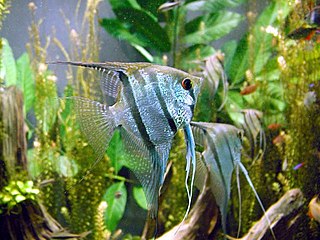 W
WCichlids are fish from the family Cichlidae in the order Cichliformes. Cichlids were traditionally classed in a suborder, Labroidei, along with the wrasses (Labridae), in the order Perciformes but molecular studies have contradicted this grouping. The closest living relatives of cichlids are probably the convict blennies and both families are classified in the 5th edition of Fishes of the World as the two families in the Cichliformes, part of the subseries Ovalentaria. This family is both large and diverse. At least 1,650 species have been scientifically described, making it one of the largest vertebrate families. New species are discovered annually, and many species remain undescribed. The actual number of species is therefore unknown, with estimates varying between 2,000 and 3,000.
 W
WCichlids are fish from the family Cichlidae in the order Cichliformes. Cichlids were traditionally classed in a suborder, Labroidei, along with the wrasses (Labridae), in the order Perciformes but molecular studies have contradicted this grouping. The closest living relatives of cichlids are probably the convict blennies and both families are classified in the 5th edition of Fishes of the World as the two families in the Cichliformes, part of the subseries Ovalentaria. This family is both large and diverse. At least 1,650 species have been scientifically described, making it one of the largest vertebrate families. New species are discovered annually, and many species remain undescribed. The actual number of species is therefore unknown, with estimates varying between 2,000 and 3,000.
 W
WAstatotilapia is a genus of small freshwater fish in the family Cichlidae found in Eastern and Northern Africa, with a single species, A. flaviijosephi, in Western Asia. Many species have been moved between this genus and Haplochromis, and while some consensus has been reached in recent years, their mutual delimitation is still far from settled. Based on mtDNA, Astatotilapia as currently defined is polyphyletic.
 W
WThe Astronotinae are a subfamily of cichlids from South America, where they are found in the Amazon, Orinoco, Paraná, and Paraguay River basins, and various rivers in the Guianas. The subfamily includes three genera, each with two species. Although in other classifications all three genera are placed in the subfamily Cichlinae with Astronotus being the only genus in the monogeneric tribe Astronotini of the subfamily Cichlinae and the other two genera being placed in the tribe Cichlini.
 W
WThe Cichlinae are a subfamily of fishes in the cichlid family, native to South America.
 W
WCleaner fish are fish that show a specialist feeding strategy by providing a service to other species, referred to as clients, by removing dead skin, ectoparasites, and infected tissue from the surface or gill chambers. This example of cleaning symbiosis represents mutualism and cooperation behaviour, an ecological interaction that benefits both parties involved. However, the cleaner fish may consume mucus or tissue, thus creating a form of parasitism called cheating. The client animals are typically fish of a different species, but can also be aquatic reptiles, mammals, or octopuses. A wide variety of fish including wrasse, cichlids, catfish, pipefish, lumpsuckers, and gobies display cleaning behaviors across the globe in fresh, brackish, and marine waters but specifically concentrated in the tropics due to high parasite density. Similar behavior is found in other groups of animals, such as cleaner shrimps.
 W
WDwarf cichlid is a term used by fishkeeping hobbyists to describe an arbitrary assemblage of small-sized fish from the family Cichlidae. Although the grouping is widely used in the aquarium industry and hobby, the grouping has no taxonomic or ecological basis and is poorly defined. Though dwarf cichlids are by definition small-sized cichlids, there is no accepted maximum length of a dwarf-sized cichlid. Some authors suggest a maximum of 10 centimetres, while other suggest a maximum length of 12 centimetres. The term is most frequently used to describe small South American or West African species which are suitable for soft, acidic densely planted aquariums, however, some aquarists and authors include within this "dwarf cichlid group" a variety of small-sized cichlids from the alkaline African rift lakes.
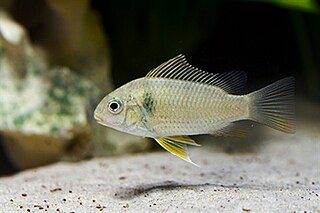 W
WEtia nguti is a species of cichlid fish endemic to Cameroon in Central Africa where it is only known from the Nguti River, a tributary of the Cross-Manyu River. This species can reach up to 13.3 centimetres (5.2 in) in standard length. It is the only member of its genus and tribe.
 W
WEtroplinae is a subfamily in the cichlid family of fishes. The subfamily includes 3 genera : Etroplus and Pseudetroplus, which are the only cichlids native to India and Sri Lanka, and Paretroplus from Madagascar.
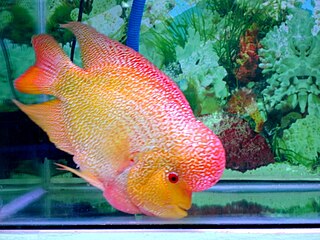 W
WFlowerhorn cichlids are ornamental aquarium fish noted for their vivid colors and the distinctively shaped heads for which they are named. Their head protuberance, or kok, is formally termed a nuchal hump. Like blood parrot cichlids, they are man-made hybrids that exist in the wild only because of their release. Flowerhorns first emerged for sale on the aquarium market in Malaysia in the late 1990s and soon became popular in many countries in Asia. First developed in Malaysia, Thailand, and Taiwan, they became very popular with Asian fish hobbyists. They are also kept by hobbyists in the US and Europe. Numerous cast-off flowerhorns have been released to the wild, especially in Singapore and Malaysia, where they have become an invasive pest animal. Their importation is banned in Australia.
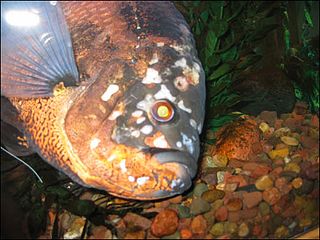 W
WHead and lateral line erosion, (HLLE) or hole-in-the-head (HITH) is a disease in fish. Chronic ulcerative dermatopathy or chronic erosive dermatopathy are symptoms of similar conditions with different etiology.
 W
WHeterotilapia is a genus of cichlid fish that are native to rivers from Guinea-Bissau to Liberia in tropical West Africa. Formerly considered a subgenus of Tilapia, in 2013, it was elevated to genus rank. They are medium-large cichlids, up to about 20–30 cm (8–12 in) in standard length depending on the species, and with a distinctive dark-and-light banded pattern. They are substrate spawners and brooders. H. buttikoferi is a common species that also has been introduced outside its native range, but H. cessiana is highly localized and critically endangered.
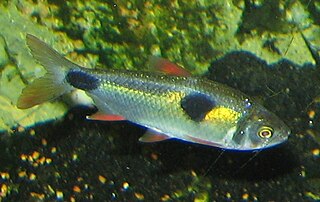 W
WLepidophagy is a specialised feeding behaviour in fish that involves eating of scales of other fish. Lepidophagy is widespread, having been independently evolved in at least five freshwater families and seven marine families. A related feeding behavior is pterygophagy, which are fish that feed on the fins of other fish.
 W
WPaedophagy in its general form is the feeding behaviour of fish or other animals whose diet is partially, or primarily the eggs or larvae of other animals. However, P. H. Greenwood, who was the first to describe paedophagia, defines it to be a feeding behaviour evolved among cichlid fishes.
 W
WPelmatolapia is a genus of cichlids native to tropical Africa. This genus and Pterochromis are the only in the tribe Pelmatolapiini, but formerly they were included in Tilapiini.
 W
WThe Pseudocrenilabrinae are a subfamily in the cichlid family of fishes to which, according to a study from 2004, includes all the Middle Eastern and African cichlids with the exception of the unusual Heterochromis multidens and the Malagasy species. This subfamily includes more than 1,100 species. Previous authors recognized additional African subfamilies, e.g. the Tilapiinae of Hoedeman (1947), Tylochrominae of Poll (1986), or Boulengerochrominae of Tawil (2001).
 W
WThe Ptychochrominae are a subfamily in the cichlid family of fish. It includes about 14 species. They are restricted to lakes and rivers in Madagascar, and the majority are threatened. Most cichlid genera native to Madagascar are included in this subfamily; the only exceptions are Paretroplus and Paratilapia.
 W
WThe terms shell dwellers or shelldwellers, shell-breeding, or ostracophil are descriptive terms for cichlid fish that use the empty shells of aquatic snails as sites for breeding and shelter. The terms have no taxonomic basis, although most shell-dwelling cichlids are from Lake Tanganyikas lamprologine lineage. Many shell dwelling cichlids are popular with fishkeepings and are frequently kept in aquaria.
 W
WThe spotted tilapia, also known as the spotted mangrove cichlid or black mangrove cichlid, is a species of fish of the cichlid family. It is native to fresh and brackish water in West and Central Africa, but has been introduced to other regions where it is considered invasive.